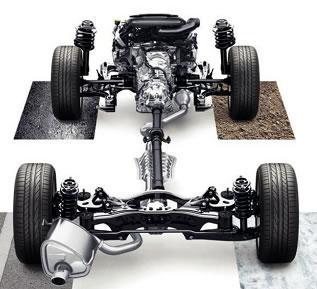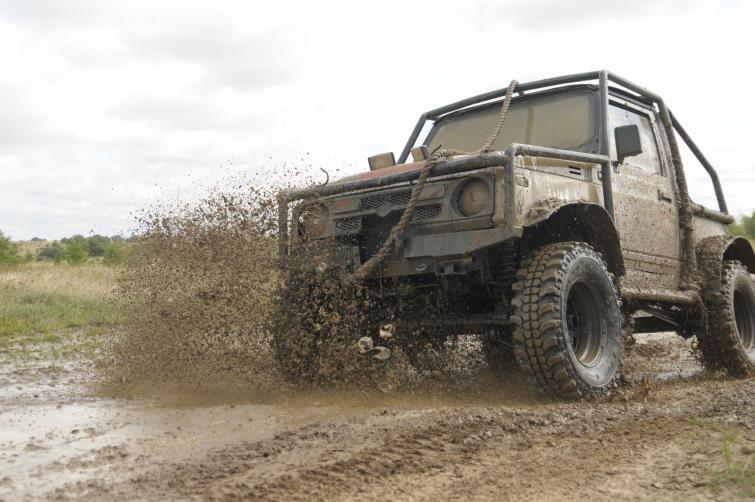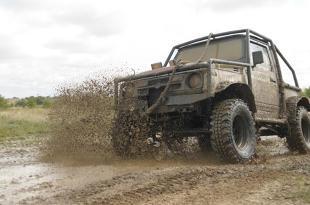
Always all-wheel drive, i.e. an overview of 4×4 drive systems
 Over the past 20 years, the 4×4 drive has made a great career. He moved from SUVs to passenger cars. Read our guide to both axle drive systems.
Over the past 20 years, the 4×4 drive has made a great career. He moved from SUVs to passenger cars. Read our guide to both axle drive systems.

Four-wheel drive, abbreviated as 4×4, is associated primarily with off-road vehicles. Its task is to improve traction, etc. off-road courage, i.e. ability to overcome obstacles. A 4x4 drive plays a similar role in a conventional car or SUV. But in this case, we are not talking about better cross-country ability, but about reducing the possibility of skidding, i.e. also about improving road grip.
See also: Types of 4 × 4 discs - photo
However, it should be noted that under the collective term "drive 4×4" many types of solutions and systems are hidden.
– The 4×4 drive works differently in a classic off-road vehicle, an off-road vehicle, and an ordinary passenger car, explains Tomasz Budny, a lover of off-road vehicles and off-road style.
The growing popularity of this solution in passenger cars is mainly driven by two brands: Subaru and Audi. Especially in the latter case, the name quattro, a proprietary solution from the German manufacturer, has proven itself well.
– The quattro drive is now an Audi brand. Depending on the model, different technological solutions are used. Currently, every fourth Audi is sold in the quattro version, says Dr. Grzegorz Laskowski, head of training at Kulczyk Tradex, which is the Polish representative of Audi.
Pluggable drive
A XNUMX-axle drive system is a matter of course in off-road vehicles. Most of these vehicles are equipped with auxiliary drive. Only one axle (usually the rear) is driven at all times, and the driver decides whether to turn on the drive to the front axle when necessary.
Until recently, almost all SUVs had two control levers in the cabin - one with a gearbox, the other with a center differential, the task of which is to connect the drive to another axle. In modern SUVs, this lever has been taken over by small switches, knobs, or even buttons that activate the 4×4 drive electronically.
See also: Turbo in the car - more power, but more trouble. Guide
To improve traction, every self-respecting SUV also has a gearbox, i.e. a mechanism that increases the torque transmitted to the wheels at the expense of speed.
Finally, for the most claimed SUVs, cars equipped with center differentials and differential locks on individual axles are intended. Such a system can be found, for example, in the Jeep Wrangler.
– This model has the ability to use three electronic limited slip differentials – front, center and rear. This solution provides a faster response to changing driving conditions and more torque transmission,” explains Krzysztof Klos, Product Specialist at Jeep Poland.
The plug-in front-wheel drive is used, in particular, in the Opel Frontera, Nissan Navara, Suzuki Jimny, Toyota Hilux.
Automatic drive
Despite the high efficiency of overcoming obstacles, the plug-in drive has some limitations. First of all, it cannot be used on hard surfaces, that is, off-road. Secondly, it is heavy and not suitable for small cars. The designers had to look for something else.
The solution is multi-plate clutches: viscous, electromechanical or electromagnetic. They play the role of a center differential, and their common feature is the automatic dosing of the drive to the axle that currently needs it. Usually only one axle is driven, but when the electronic sensors detect a slip on the drive axle, some of the torque is transferred to the other axle.
Viscous coupling
Until recently, this was a very popular 4x4 system in passenger cars and some SUVs. The advantages are simple structure and low production costs.
See also: Brake system - when to change pads, discs and fluid - guide
The system consists of a multi-disc viscous clutch filled with thick oil. Its task is to automatically transmit torque to the second axle. This happens only when there is a large difference in the speed of rotation of the front and rear wheels. The disadvantage of this solution is the possibility of overheating of the mechanism.
Electromechanical clutch
Electronics plays the first violin here. A special controller is installed in the drive system, the task of which is to control the clutch based on sensor data that monitors the movement of the car.
This system can withstand much greater loads than a viscous coupling. Fiat and Suzuki (Fiat Sedici and Suzuki SX4 models) are in favor of this solution.
Electromagnetic clutch
In this case, the multi-disk mechanism works according to the electromagnetic principle. It can transfer torque to axles 50 percent to 50 percent. The system is activated when there is a difference in speed between the front and rear wheels.
An example of this in complex form is the BMW xDrive system. The drive is assisted by an ESP system and a braking system that can lock differentials on both axles.
The disadvantage of both of these clutches - electromechanical and electromagnetic - is a complex design, which increases the cost of production and, consequently, the price of the car. They are quite durable, but in the event of a breakdown, repair costs are significant.
See also: xenon or halogen? Which headlights to choose for a car - a guide
In addition to BMW, Fiat and Suzuki, the 4×4 drive automatically distributes torque between axles, including. B: Honda CR-V, Jeep Compass, Land Rover Freelander, Nissan X-Trail, Opel Antara, Toyota RAV4.
Haldex, Thorsen and 4Matic
Haldex and Torsen systems are the development of the idea of automatic distribution of the drive between the axles.
Haldex
The design was invented by the Swedish company Haldex. In addition to the multi-plate clutch, an extensive hydraulic system is used to transfer power between the axles. The advantage of this solution is the possibility of its interaction with the engine located transversely. In addition, it has a relatively small weight, but is difficult to repair.
Haldex is Volvo and Volkswagen's favorite all-wheel drive system.
torsos
This type of 4×4 drive is based on a gearbox with three pairs of worm gears, which automatically distributes torque between the axles. In normal driving, the drive is transferred to the axles in a 50/50 percent ratio. In the event of a skid, the mechanism can transfer up to 90% of the torque to the axle where the skid does not occur.
Thorsen is a fairly effective system, but it also has drawbacks. The main one is the complex structure and the relatively high cost of production. That is why Torsen can be found in higher class cars, incl. in Alfa Romeo, Audi or Subaru.
See also: Clutch - how to avoid premature wear? Guide
By the way, the term Torsen should be clarified. Contrary to popular belief, it does not come from a surname, but is an abbreviation of the first parts of two English words: Torque and Sensing.
Also worth mentioning is the 4Matic system used by Mercedes, which uses three differentials. Permanent drive on both axles is distributed in the proportion of 40 percent. front, 60 percent rear.
Interestingly, the issue with the differential lock was resolved. In this system, the role of locks is assigned to the brakes. If one of the wheels begins to slip, it is momentarily braked and more torque is transferred to the wheels with better grip. Everything is electronically controlled.
The advantage of the 4Matic system is its low weight, since the designers managed to eliminate many mechanical parts. However, the disadvantage is the high price. Mercedes uses, among other things, the 4Matic system. in class C, E, S, R and SUVs (class M, GLK, GL).
Wojciech Frölichowski
